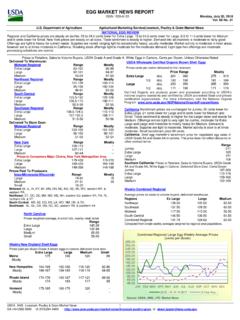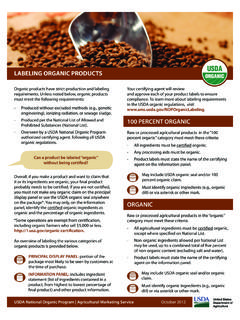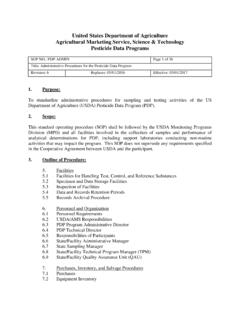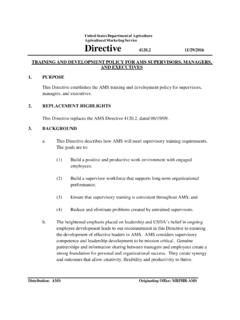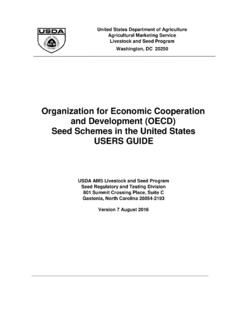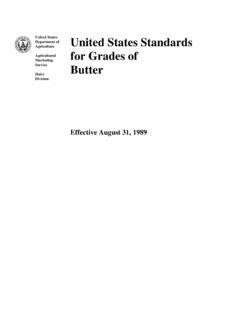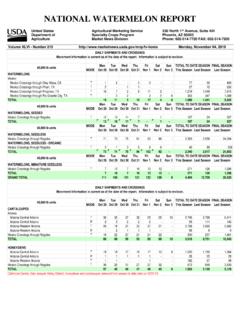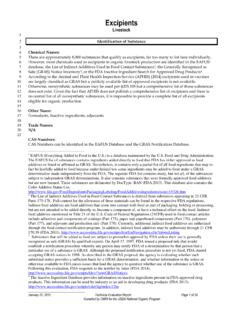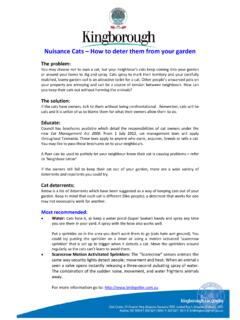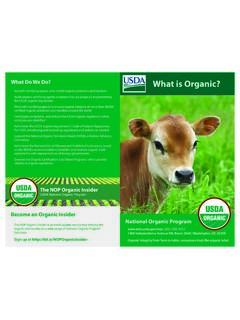Transcription of United States Egg-Grading Manual
1 AUnited StatesDepartment ofAgricultureAgriculturalMarketingServic eAgricultural Handbook Number 75 Egg-GradingManualiContentsI. Production and Maintenance of Egg and ..3 Feeding ..3 Care of Eggs on the Farm ..4 Egg-processing Facilities ..4 Buildings and Premises ..5 Washing, Grading, and Packing Operations and Equipment ..6 Cooling Facilities ..9 Health and Cleanliness of Employees ..10 Distribution ..10 III. Structure, Composition, and Formation of the Egg ..11 Physical Structure ..11 Composition .. of the of the of the Shell of the of Quality of Exterior Quality Shape and of of Interior Quality ..20 Interior Quality ..22 White (Albumen)..24 Loss Standards, Grades, and Weight Classes for Shell Standards for Quality of Individual Shell Consumer Grades and Weight Classes for Shell Nest Run Grade and Weight Classes for Shell Grades and Weight Determining Interior Quality by Hand Candling Candling Candling Determining Interior Quality by the Breakout Control Egg Grading and Certification Grading of Official Grade Labeling and Certification to Specific Purchase Shell Plant Sanitation and Good Manufacturing Practices (PSGMP) Legislation Affecting Grading and Marketing of Egg Quality Schools and Training Resource Materials IntroductionThis Manual is an aid in teaching both beginning andexperienced egg graders the correct interpretation andapplication of the standards, grades, and weightclasses for eggs.
2 It can serve as a guide in short courses orgrading schools when supplemented with lectures, groupdiscussions, and demonstrations. This Manual should alsoprove useful to those teaching or working in the produc-tion, processing, and marketing of some of the material in this Manual is notdirectly related to the actual grading function, knowledgeof it will help graders do a better job in handling eggs andin maintaining egg quality. Such information will givegraders a better understanding of their job, and will aidthem in acquiring the knowledge necessary to do theirjobs Manual provides graders with an understanding ofegg marketing, the purpose of grading, production andprocessing practices, and Federal-State grading in-depth description of USDA s egg grading and certi-fication programs is provided for use by processors, mar-keters, volume food buyers, and retailers to enhance theirprocurement and quality control is also included about the formation, structure, and composition of the egg.
3 The egg is a bio-logical structure used in nature for the reproduction ofthe chicken. It protects the developing chick embryo,provides it a complete diet, and serves as the principalsource of nutrition for the first few days of the chick slife. The egg also serves as one of the most nutritiousand versatile of human foods. Chickens produce eggs in abundance, making this source of food extremelyimportant throughout the world, nutritionally as well as modern trend in production is toward large, highlyspecialized flocks. The high-quality egg produced underthis system lends itself very well to the use of machine-flash candling equipment or mass electronic scanningdevices to detect checks, irregular shells, dirts, meat andblood spots, and loss eggs. For this reason, it is highlydesirable for graders to have a working knowledge ofthese of the various qualities of individual eggsshould assist the student grader in understanding eggquality.
4 However, it is imperative that the descriptions ofthe different qualities be compared with eggs before thecandling light, and that the quality interpretations bechecked by experienced importance of practice in candling cannot be stressedenough. It is essential that student graders become thor-oughly familiar with the descriptions of the different qual-ities because the final measure of their ability is the accu-racy by which they interpret quality before the candlinglight. Occasional comparisons of broken-out appearancewith candled appearance are also essential in developinggrading quality and grading procedures are the what and how of the job. Coupled with reasonably good judg-ment, practice, and guidance, graders should acquire thenecessary skills to rapidly determine the proper classifica-tion of shell eggs based on official standards of Production and Maintenanceof Egg QualityEgg production has been, and continues to be, a majoragricultural industry in the United States .
5 In 1999, totalegg production was almost 7 billion dozen. The northcentral area continues to lead the Nation in production,followed by the west and the middle Atlantic and marketing this volume of quality eggshave been accompanied by specialization in the areas ofbreeding, hatching chicks, raising chickens, producingeggs, and producing poultry meat. Large vertically inte-grated firms that perform several or all of these functionshave become most prominent. The average flock size foran operation often exceeds 75,000 layers, with manyover 1 is either off-line or in-line. Off-line pro-duction refers to processing operations that are not inte-grated with the laying facility. Off-line eggs are gatheredand shipped in from laying facilities at other locations. In-line production refers to processing operations whereeggs are laid, processed, packed, and shipped from onelocation. Most production facilities today are large inte-grated in-line operations.
6 An understanding of egg pro-duction practices will help processors and quality controlpersonnel contend with product quality White Leghorn is the predominant breed of layerbeing raised, in part because it lays white-shell eggs are available in some parts of the coun-try, but white-shell eggs are more widely demanded byconsumers. Shell color and thickness, egg size, qualityand quantity of thick white, quantity of eggs produced,and, to some extent, freedom from blood spots arehereditary factors that affect overall egg quality. Forexample, broken and cracked egg shells are directly relat-ed to shell thickness and strength, and have great eco-nomic impact on the industry. Also, a reduction in shellquality is a direct result of increased egg time, improvements in these hereditary factorshave been bred into the White Leghorn. Chicks or pul-lets for the initial flock or flock replacement should beprocured from a source that can give reasonable assur-ance that these factors have been carefully considered inthe breeding promote improved breeding and production qualitiesin poultry and to reduce losses from pullorum disease,the industry established the National PoultryImprovement Plan (NPIP) in , NPIP is administered jointly by USDA s AgriculturalResearch Service and an official State agency in each ofthe cooperating States .
7 It operates according to regula-tions and standards developed to provide assistance tobreeders and hatcheries in producing birds free from egg-transmitted diseases. Procurement of chicks from plan hatcheries assists the producer in the selection of desir-able young stock. In 1989, NPIP developed a Salmonellaenteritidis (Se) control program to reduce the incidence ofSein hatching eggs and chicks. Participants in this pro-gram follow designated control procedures and practicesat breeder farms and and RaisingSome operators brood chicks and raise them to layingage, while others purchase 16- to 20-week-old birds fromspecialists in the pullet-raising field. The brooding periodusually involves the first 6 to 8 weeks of the chick s lifeand is the most critical period for the bird in reaching its full potential. Temperature, feed, water, and environ-mental stress must be controlled and monitored continu-ously.
8 A properly managed feeding program assures uni-form growth and a manageable egg production intensity and duration of light during the broodingand growout period have a dramatic effect on growth andsexual maturity. Today, most brooding and growout oper-ations are environmentally controlled, which means thelighting and other factors can be automatically controlledfor optimum ago, many producers utilized the practice of cullingflocks. Culling is the careful evaluation, either visual orphysical, of a flock to remove birds that are diseased orweak and cannot reach their full level of breeding and production technology has virtual-ly eliminated the need for culling. Today, most layers arekept in production for a laying period of 12 to 14 monthsunless they are force is the natural loss of feathers that generallyoccurs annually late in the summer. During the moltingperiod, which usually lasts 45 to 60 days, egg productionstops and the chicken s reproductive system molting is a controlled production practice that,depending on the current economic situation, can have asignificant effect on production income.
9 Cost of feed, eggprices, and cost of layer replacements are factors thatmust be considered before committing to a force moltingprogram. Force molting is usually induced by a with-drawal of feed followed by a low-protein, high-calciumdiet until production housing is essential for efficient egg that are comfortable are healthier than birds keptunder improper conditions, and production costs arelower. Environmental temperature and air circulationare critical, with the optimum temperature beingbetween 57 and 79 F ( and C).Temperatures outside this range affect feed conversion,egg production, egg quality, and water and feeders, whether the Manual or mechani-cal type, should be kept clean. Dirt and dust should beheld to a minimum. Controlled ventilation and, wherenecessary, adequate insulation should be provided tohave the proper temperature and humidity should be avoided, and the equipmentand facilities should be kept in good , over 90 percent of all table eggs produced inthe United States are from caged layers, primarilybecause of economics.
10 Eggs produced in cages cost lessto produce than those in floor systems due to muchmore intensive labor and floor space requirements withthe latter. Most new operations are environmentallycontrolled multiple-level cage systems that are com-pletely automated with mechanical feeding and water-ing equipment and conveyor belts that carry the eggsout of the laying house. Environmental housing alsoprovides a method of controlling temperature, light,and humidity. Additionally, controlled housing providesprotection from predators and disease-carrying rodentsand shares the limelight with breeding in the pro-duction of high-quality eggs. With recent advances inpoultry nutrition and the use of computers for formulat-ing, a dozen eggs can now be produced on less than 4 Figure 2. Automated multi-deck caged layer system. (CD 8202 3241 1143-89)Large-capacity feed tanks provide a continuous supply of feed to each layer house.
